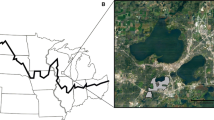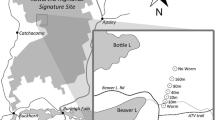Abstract
The invasion of North American forests by exotic earthworms is producing profound ecosystem changes, such as alterations in soil nutrient cycling, and redistribution and loss of soil organic matter. However, the present and future extent of these invasions is difficult to evaluate without a better understanding of the factors that control the distribution and abundance of earthworms in previously non-invaded habitats. In this study, the species composition and short-term dynamics of three exotic earthworm invasion fronts were studied at a northern hardwood forest in south-central New York State (USA). Belt transects were established at each of the three locations to sample from earthworm-invaded areas through transition zones and into invasion front areas. Lumbricus rubellus, L. terrestrisandOctolasion tyrtaeum were the most common species, but their distribution was not homogeneous along the transects. Whereas, L. rubellus was the only species with relatively high adult densities at transition zones and invasion fronts, L. terrestris and O. tyrtaeum occurred mostly in the heavily earthworm-invaded areas and were rare at the invasion fronts. The density of earthworms along the transects decreased by 60–87 from June 2001 to October 2002 and then recovered in 2003 to values similar to those of 2001. This decrease was apparently caused by reduced recruitment of immature earthworms, probably related to the severe drought periods that the study area experienced in 2001 and 2002. Our data suggest that climate and topography, through their effects on soil moisture patterns, can be critical factors controlling the distribution and spread of exotic earthworms in previously non-invaded habitats.
Similar content being viewed by others
References
DH Alban and EC Berry, Effects of earthworm invasion on morphology, carbon, and nitrogen of a forest soil. Applied Soil Ecology 1 (1994) 243-249
DE Bailey, DK Rossenberg, W Fender, D McKey-Fender and J Jacobs, Patterns of abundance and habitat associations of earthworms in remnant forests of Willamette Valley, Oregon. Northwest Science 76 (2002) 26-34
PJ Bohlen, PM Groffman, TJ Fahey, MC Fisk, E Suárez, DM Pelletier and RT Fahey, Ecosystem consequences of exotic earthworm invasion of North Temperate Forests. Ecosystems 7 (2004) 1-12
PJ Bohlen, DM Pelletier, PM Groffman, TJ Fahey and MC Fisk, Influence of earthworm invasion on redistribution and retention of soil carbon and nitrogen in northern temperate forests. Ecosystems 7 (2004b) 13-28
AE Burtelow, PJ Bohlen and PM Groffman, Influence of exotic earthworm invasion on soil organic matter, microbial biomass and denitrification potential in forest soils of the northeastern United States. Applied Soil Ecology 9 (1998) 197-202
KR Butt, MJ Shipitalo, PJ Bohlen, WM Edwards and RW Parmelee, Long-term trends in earthworm populations of cropped experimental watersheds in Ohio, USA. Pedobiologia 43 (1999) 713-719
MA Callaham and P Hendrix, Relative abundance and seasonal activity of earthworms (Lumbricidae and Megascolecidae) as determined by hand-sorting and formalin extraction in forest soils on the Southern Appalachian Piedmont. Soil Biology and Biochemistry 29 (1997) 317-321
M Cannavacciuolo, A Bellido, D Cluzeau, C Gascuel and P Trehen, A geostatistical approach to the study of earthworm distribution in grassland. Applied Soil Ecology 9 (1998) 345-349
DCF Cotton and JP Curry, Earthworm distribution and abundance along a mineral-peat soil transect. Soil Biology and Biochemistry 14 (1982) 211-214
T Decaens and JP Rossi, Spatio-temporal structure of earthworm community and soil heterogeneity in a tropical pasture. Ecography 24 (2001) 671-682
P Dymond, S Scheu and D Parkinson, Density and distribution of Dendrobaena octaedra (Lumbricidae) in Aspen and Pine forests in the Canadian Rocky Mountains (Alberta). Soil Biology and Biochemistry 29 (1997) 265-273
CA Edwards and PJ Bohlen, Biology and Ecology of Earthworms. London: Chapman & Hall (1996).
TJ Fahey, Recent changes in an upland forest in south-central New York. Journal of the Torrey Botanical Society 125 (1998) 51-59
JJ Fain, TA Volk and TJ Fahey, Fifty years of change in an upland forest in south-central New York: general patterns. Bulletin of the Torrey Botanical Club 121 (1994) 130-139
MC Fisk, TJ Fahey, PM Groffman and PJ Bohlen, Earthworm invasion, fine root distributions and soil respiration in north temperate forests. Ecosystems 7 (2004) 55-62
C Fragoso, I Barois, C González, C Arteaga and JC Patrón, Relationship between earthworms and soil organic matter levels in natural and managed ecosystems in the Mexican tropics. In: K Mulongoy and R Merckx (eds.) Soil Organic Dynamics and Sustainability of Tropical Agriculture.. Leuven: A Wiley-Sayce Co Publication (1993) pp. 231-241
GE Gates, On the earthworm fauna of the Great American Desert and adjacent areas. Great Basin Naturalist 27 (1967) 142-176
GE Gates, Farewell to North American megadriles. Megadrilogica 4 (1982) 12-77
PM Groffman, CT Driscoll, TJ Fahey, JP Hardy, RD Fitzhugh and GL Tierney, Colder soils in a warmer world: a snow manipulation study in a northern hardwood forest ecosystem. Biogeochemistry 56 (2001) 135-150
P Hendrix, Earthworm ecology and biogeography in North America. Boca Raton: Lewis Publishers (1995).
P Hendrix and PJ Bohlen, Exotic earthworm invasions in North America: ecological and policy implications. Bioscience 52 (2002) 801-811
SW James, Systematics, Biogeography and Ecology of Neartic Earthworms from Eastern, Central, Southern and Southwestern United States. In: P Hendrix (ed.) Earthworm Ecology and Biogeography in North America.. Boca Raton, Ann Arbor, London, Tokyo: Lewis Publishers (1995) pp. 29-51
KE Lee, Earthworms: Their Ecology and Relationships with Soils And Land Use. Sydney, Australia: Academic Press (1985).
P Margerie, T Decaens, F Bureau and D Alard, Spatial distribution of earthworm species in a chalky slope of the Seine Valley (Normandy, France). European Journal of Soil Biology 37 (2001) 291-296
JCY Marinissen and F Bosch van den, Colonization of new habitat by earthworms. Oecologia 91 (1992) 371-376
MA McLean and D Parkinson, Field evidence of the effects of the epigeic earthworm Dendrobaena octaedra on the microfungal community in pine forest floor. Soil Biology and Biochemistry 32 (2000a) 351-360
MA McLean and D Parkinson, Introduction of the epigeic earthworm Dendrobaena octaedra changes the oribatid community and microarthropod abundance in a pine forest. Soil Biology and Biochemistry 32 (200b) 1671-1681
RB Owen Jr and WJ Galbraith, Earthworm biomass in relation to forest types, soil, and land use: implications for woodcock management. Wildlife Society Bulletin 17 (1989) 130-136
J Phillipson, R Abel, J Steel and SRJ Woodell, Earthworms and the factors governing their distribution in an English beechwood. Pedobiologia 16 (1976) 258-285
F Raw, Estimating earthworm populations by using formalin. Nature 184 (1959) 1661-1662
JP Rossi, Clusters in earthworm spatial distribution. Pedobiologia 47 (2004a) 490-497
JP Rossi, The spatiotemporal pattern of a tropical earthworm species assemblage and its relationship with soil structure. Pedobiologia 47 (2004b) 497-503
JP Rossi, Short-range structures in earthworm spatial distribution. Pedobiologia 47 (2004c) 582-587
SAS-Institute (1987) SAS Statistics user’s guide. Cary, NC
JE Satchell and DA Stone, Colonization of fuel ash sites by earthworms. Publicación del Centro Pirenaico de Biología Experimental 9 (1977) 59-74
S Scheu and D Parkinson, Effects of earthworms on nutrient dynamics, carbon turnover and microorganisms in soils from cool temperate forests of the Canadian Rocky Mountains – laboratory studies. Applied Soil Ecology 1 (1994a) 113-125
S Scheu and D Parkinson, Effects of invasion of an Aspen forest (Canada) by Dendrobaena octaedra (Lumbricidae) on plant growth. Ecology 75 (1994b) 2348-2361
SH Shakir and DL Dindal, Density and biomass of earthworms in forest and herbaceous microecosystems in central New York, North America. Soil Biology and Biochemistry 29 (1997) 276-285
E Suárez, DM Pelletier, TJ Fahey, PM Groffman, PJ Bohlen and MC Fisk, Effects of exotic earthworms on soil phosphorus cycling in two broadleaf temperate forests. Ecosystems 7 (2004) 28-44
Suárez E, Tierney G, Fahey TJ and Fahey R (in review) Understanding patterns of exotic earthworm distribution in a temperate hardwood forest in South-Central New York, USA. Accepted pending revisions. Landscape Ecology
Author information
Authors and Affiliations
Corresponding author
Rights and permissions
About this article
Cite this article
Suárez, E.R., Fahey, T.J., Groffman, P.M. et al. Spatial and Temporal Dynamics of Exotic Earthworm Communities Along Invasion Fronts in a Temperate Hardwood Forest in South-Central New York (USA). Biol Invasions 8, 553–564 (2006). https://doi.org/10.1007/s10530-005-1196-y
Received:
Accepted:
Published:
Issue Date:
DOI: https://doi.org/10.1007/s10530-005-1196-y




